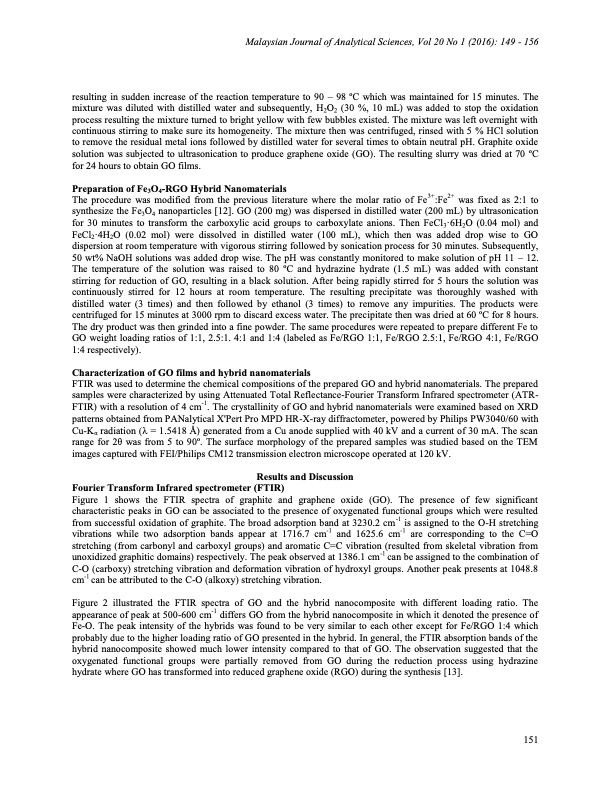
PDF Publication Title:
Text from PDF Page: 003
Malaysian Journal of Analytical Sciences, Vol 20 No 1 (2016): 149 - 156 resulting in sudden increase of the reaction temperature to 90 – 98 oC which was maintained for 15 minutes. The mixture was diluted with distilled water and subsequently, H2O2 (30 %, 10 mL) was added to stop the oxidation process resulting the mixture turned to bright yellow with few bubbles existed. The mixture was left overnight with continuous stirring to make sure its homogeneity. The mixture then was centrifuged, rinsed with 5 % HCl solution to remove the residual metal ions followed by distilled water for several times to obtain neutral pH. Graphite oxide solution was subjected to ultrasonication to produce graphene oxide (GO). The resulting slurry was dried at 70 oC for 24 hours to obtain GO films. Preparation of Fe3O4-RGO Hybrid Nanomaterials 3+ 2+ The procedure was modified from the previous literature where the molar ratio of Fe :Fe was fixed as 2:1 to synthesize the Fe3O4 nanoparticles [12]. GO (200 mg) was dispersed in distilled water (200 mL) by ultrasonication for 30 minutes to transform the carboxylic acid groups to carboxylate anions. Then FeCl3·6H2O (0.04 mol) and FeCl2·4H2O (0.02 mol) were dissolved in distilled water (100 mL), which then was added drop wise to GO dispersion at room temperature with vigorous stirring followed by sonication process for 30 minutes. Subsequently, 50 wt% NaOH solutions was added drop wise. The pH was constantly monitored to make solution of pH 11 – 12. The temperature of the solution was raised to 80 oC and hydrazine hydrate (1.5 mL) was added with constant stirring for reduction of GO, resulting in a black solution. After being rapidly stirred for 5 hours the solution was continuously stirred for 12 hours at room temperature. The resulting precipitate was thoroughly washed with distilled water (3 times) and then followed by ethanol (3 times) to remove any impurities. The products were centrifuged for 15 minutes at 3000 rpm to discard excess water. The precipitate then was dried at 60 oC for 8 hours. The dry product was then grinded into a fine powder. The same procedures were repeated to prepare different Fe to GO weight loading ratios of 1:1, 2.5:1. 4:1 and 1:4 (labeled as Fe/RGO 1:1, Fe/RGO 2.5:1, Fe/RGO 4:1, Fe/RGO 1:4 respectively). Characterization of GO films and hybrid nanomaterials FTIR was used to determine the chemical compositions of the prepared GO and hybrid nanomaterials. The prepared samples were characterized by using Attenuated Total Reflectance-Fourier Transform Infrared spectrometer (ATR- FTIR) with a resolution of 4 cm-1. The crystallinity of GO and hybrid nanomaterials were examined based on XRD patterns obtained from PANalytical X'Pert Pro MPD HR-X-ray diffractometer, powered by Philips PW3040/60 with Cu-Kα radiation ( = 1.5418 Å) generated from a Cu anode supplied with 40 kV and a current of 30 mA. The scan range for 2θ was from 5 to 90o. The surface morphology of the prepared samples was studied based on the TEM images captured with FEI/Philips CM12 transmission electron microscope operated at 120 kV. Results and Discussion Fourier Transform Infrared spectrometer (FTIR) Figure 1 shows the FTIR spectra of graphite and graphene oxide (GO). The presence of few significant characteristic peaks in GO can be associated to the presence of oxygenated functional groups which were resulted from successful oxidation of graphite. The broad adsorption band at 3230.2 cm-1 is assigned to the O-H stretching vibrations while two adsorption bands appear at 1716.7 cm-1 and 1625.6 cm-1 are corresponding to the C=O stretching (from carbonyl and carboxyl groups) and aromatic C=C vibration (resulted from skeletal vibration from unoxidized graphitic domains) respectively. The peak observed at 1386.1 cm-1 can be assigned to the combination of C-O (carboxy) stretching vibration and deformation vibration of hydroxyl groups. Another peak presents at 1048.8 cm-1 can be attributed to the C-O (alkoxy) stretching vibration. Figure 2 illustrated the FTIR spectra of GO and the hybrid nanocomposite with different loading ratio. The appearance of peak at 500-600 cm-1 differs GO from the hybrid nanocomposite in which it denoted the presence of Fe-O. The peak intensity of the hybrids was found to be very similar to each other except for Fe/RGO 1:4 which probably due to the higher loading ratio of GO presented in the hybrid. In general, the FTIR absorption bands of the hybrid nanocomposite showed much lower intensity compared to that of GO. The observation suggested that the oxygenated functional groups were partially removed from GO during the reduction process using hydrazine hydrate where GO has transformed into reduced graphene oxide (RGO) during the synthesis [13]. 151PDF Image | GRAPHENE-BASED MAGNETIC HYBRID NANOCOMPOSITE

PDF Search Title:
GRAPHENE-BASED MAGNETIC HYBRID NANOCOMPOSITEOriginal File Name Searched:
JashielaWani-20-1-16.pdfDIY PDF Search: Google It | Yahoo | Bing
Salgenx Redox Flow Battery Technology: Power up your energy storage game with Salgenx Salt Water Battery. With its advanced technology, the flow battery provides reliable, scalable, and sustainable energy storage for utility-scale projects. Upgrade to a Salgenx flow battery today and take control of your energy future.
| CONTACT TEL: 608-238-6001 Email: greg@infinityturbine.com | RSS | AMP |